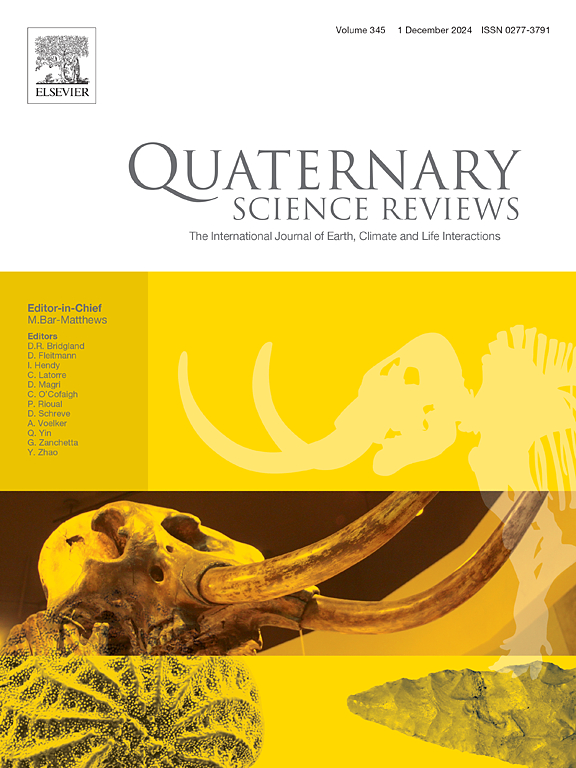Geomorphology, first 36Cl datings and chrono-evolutionary model of Mount Aragats paleoglaciers (Armenia)
IF 3.2
1区 地球科学
Q1 GEOGRAPHY, PHYSICAL
引用次数: 0
Abstract
Mount Aragats is one of the largest glaciated volcanoes of the Armenian Highlands (Հայկական լեռնաշխարհ) and culminating in the Aragats Peak, the highest peak of the Republic of Armenia (4090 masl). Here, prehistoric societies have been present for millennia, so assessing the local influence of past glaciations is a crucial factor to better understand the cultural evolution of this region. Therefore, this work focuses on a detailed study of the morphology and morphostratigraphic succession of Mount Aragats paleoglaciers. Geomorphic-based paleoglacier reconstruction along 36Cl cosmogenic dating (n = 13) of moraines reveal that during the Middle and Upper Pleistocene, a plateau glacier featuring ice lobes covered this area, featuring outlet lobes reaching up to 17 km in length, thicknesses of up to 350 m and descending to 2040 masl. According to the morphostratigraphic succession of ice-marginal features, absolute chronologies and regional correlations, the chronoevolutionary sequence of these glaciers comprises three intervals: (1) The absolute Maximum Ice Extent or Aragats Glacial Maximum occurred during the Penultimate Glacial Cycle within the MIS6e (c. 180 ka). (2) Subsequently, during the Last Glacial Cycle, the Maximum Ice Extent occurred during the MIS5d (c. 111 ka) followed by two secondary glacial maxima stabilizations during the MIS3a (c. 37 ka) and the MIS2 (c. 17 ka). Finally, (3) the Post-Glacial Period (PCP, Holocene, MIS1). The disappearance of the glaciers on Mount Aragats was established at the beginning of the second half of the 20th century by direct observations. The current morphodynamic environment corresponds to active rock glaciers, some névè moraines and widespread activity of slope processes such as debris flow and debris slides.
亚美尼亚阿拉加特山古冰川的地貌、第一次36Cl定年及年代演化模式
阿拉加特山是亚美尼亚高地最大的冰川火山之一(Հ),最终到达阿拉加特峰,亚美尼亚共和国的最高峰(4090 masl)。在这里,史前社会已经存在了数千年,因此评估过去冰川对当地的影响是更好地了解该地区文化演变的关键因素。因此,本文着重对阿拉加特山古冰川的形态和形态地层演替进行了详细的研究。根据冰碛物36Cl宇宙测年(n = 13)重建的古冰川显示,在中上更新世期间,该地区覆盖了一个以冰裂片为特征的高原冰川,其出口裂片长度达17 km,厚度达350 m,下降至2040 masl。根据冰缘特征的形态地层演替、绝对年代学和区域对比,这些冰川的时间演化序列包括三个区间:(1)绝对最大冰域或阿拉加特冰川最大值发生在MIS6e(约180 ka)的第二次冰旋回期间。(2)末次冰旋回期间,最大冰期出现在MIS5d (c. 111 ka),其次是MIS3a (c. 37 ka)和MIS2 (c. 17 ka)两个次冰川最大稳定期。(3)后冰期(PCP,全新世,MIS1)。阿拉加特山冰川的消失是在20世纪下半叶初通过直接观测确定的。当前的形态动力学环境对应于活跃的岩石冰川,一些névè冰碛和广泛的泥石流和泥石流等斜坡过程的活动。
本文章由计算机程序翻译,如有差异,请以英文原文为准。
求助全文
约1分钟内获得全文
求助全文
来源期刊

Quaternary Science Reviews
地学-地球科学综合
CiteScore
7.50
自引率
15.00%
发文量
388
审稿时长
3 months
期刊介绍:
Quaternary Science Reviews caters for all aspects of Quaternary science, and includes, for example, geology, geomorphology, geography, archaeology, soil science, palaeobotany, palaeontology, palaeoclimatology and the full range of applicable dating methods. The dividing line between what constitutes the review paper and one which contains new original data is not easy to establish, so QSR also publishes papers with new data especially if these perform a review function. All the Quaternary sciences are changing rapidly and subject to re-evaluation as the pace of discovery quickens; thus the diverse but comprehensive role of Quaternary Science Reviews keeps readers abreast of the wider issues relating to new developments in the field.
 求助内容:
求助内容: 应助结果提醒方式:
应助结果提醒方式:


